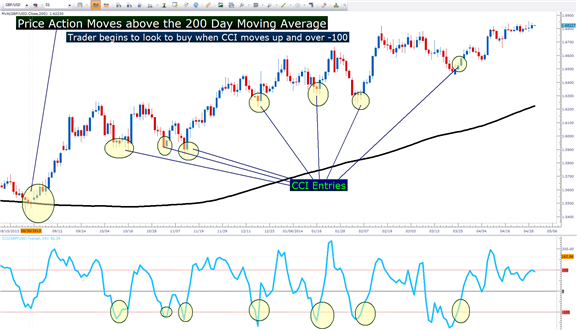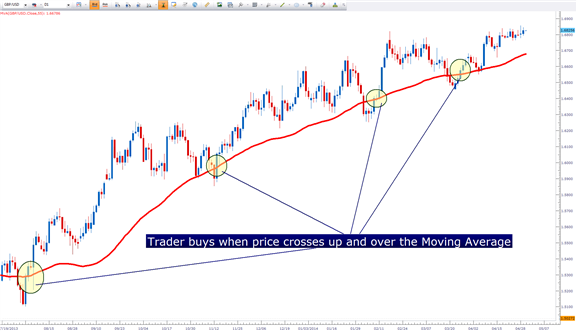Forum on trading, automated trading systems and testing trading strategies
Libraries: The Moving Average Class
Sergey Golubev, 2014.05.01 09:53
Three Ways to Trade with Moving Averages
- Traders can use mathematical averaging to their advantage by employing the moving average.
- Moving averages can be used to initiate positions in the direction of the trend.
- Traders can incorporate multiple moving averages to fit in their strategy to accomplish specific goals.
Indicators can be tricky tools. Knowing which ones to use and how to use
them can be complicated enough; but finding out how to properly employ
an entire strategy in the right market environment can be the most
difficult question for traders to address.
The Moving Average is simply the last x period’s closing prices added
together, and divided by the number of observed periods (x). And it’s in
its simplicity lies its beauty. When prices are trending higher, the
moving average will reflect this by also moving higher. And when prices
are trending lower, these new lower prices will begin to be factored
into the moving average and it too will begin moving lower.
While this averaging effect brings on an element of lag, it also allows
the trader an ideal way of categorizing trends and trending conditions.
In this article, we’re going to discuss three different ways this
utilitarian indicator can be employed by the trader.
As a Trend-Filter
Because the moving average does such a great job of identifying the
trend, it can be readily used to offer traders a trend-side bias in
their strategies. So if price action is above a moving average, only
long positions are looked at while price action below the moving average
mandates that only short positions are taken.
For this trend-filtering effect, longer-term moving averages generally
work better as faster-period settings may be too active for the desired
filtering effect. The 200 Day Moving Average is a common example, which
is simply the last 200 day’s closing prices added together and divided
by 200.
After a bias has been obtained and traders know which direction they
want to look to trade in a market, positions can be triggered in a
variety of ways. An oscillator such as RSI or CCI can help traders catch
retracements by identifying short-term overbought or oversold
situations.
In the picture below, we show an example of a CCI (Commodity Channel Index) Entry with the 200 day moving average as a trend filter.

As a trigger to initiate positions
Taking the idea of strategy development a step further, the logic of the
moving average can also be used to actually open new positions.
After all, if price action is showing a trending state just by residing
above a moving average, doesn’t logic dictate that the very action of
crossing that moving average can have trending connotations as well?
So traders can also use the price/moving average crossover as a trigger into new positions, as shown below.
The Moving Average can also be used to initiate positions in the direction of the trend

The downside to the moving average trigger is that choppy or trend-less
markets can invite sloppy entries as congested prices meander back and
forth around a specific MA. So it’s highly suggested to avoid using a
moving average trigger in isolation without any other filters or
limitations. Doing so could mean massive losses if markets congest or
range for prolonged periods of time.
As a Crossover Trigger
The third and final way that moving averages can be implemented is with
the moving average crossover. This is an extremely common way of
triggering trades, but has the undesired impact of being especially
‘laggy’ by introducing two different lagging indicators rather than just
one (as is the case of using the MA as a filter or a trigger
individually).
Common examples of moving average crossovers are the 20 and 50 period
crossovers, the 20 and 100 period crossover, the 20 and 200 period
crossover, and the 50 and 200 period crossover (commonly called ‘the
death cross’ when the 50 goes below the 200, or the ‘golden cross’ when
the 50 goes above the 200).
The 50 Day/200 Day Moving Average Crossover :

This can be taken a step further with multiple time frame analysis.
Traders can look to a longer-term chart to use a moving average filter
as we had outlined in the (1) part of this article, and then the
crossover can be used as a trigger in the direction of the trend on the
shorter time frame.
While no indicator is going to be perfect, these three methods show the
utility that can be brought to the table with the moving average, and
how easily traders can use this versatile tool to trigger trades ahead
and in front of very large, outsized moves in the market.
- Free trading apps
- Over 8,000 signals for copying
- Economic news for exploring financial markets
You agree to website policy and terms of use
Hello,
what is your opinion on MA crossovers?
Do you know any site where I can read more about them?
Regards